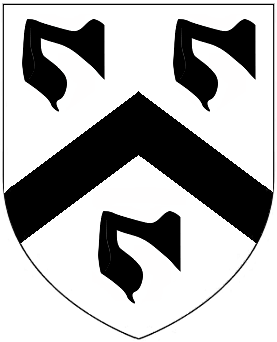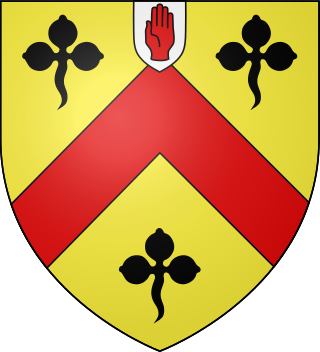
Lord Napier, of Merchistoun, is a title in the Peerage of Scotland. It was created in 1627 for Sir Archibald Napier, 1st Baronet. Earlier that year, he already held the Napier Baronetcy, of Merchistoun in the County of Midlothian, created in the Baronetage of Nova Scotia. The titles remained united until 1683, when the Baronetcy became dormant. It was revived in the early 19th century and is now held by another branch of the Napier family. Between 1683 and 1686, the Lords of Napier also held the Nicolson Baronetcy, of Carnock in the County of Stirling, and since 1725 the Scott Baronetcy, of Thirlestane in the County of Selkirk, both baronetcies created in the Baronetage of Nova Scotia. The latter is still held today. Additionally, the tenth Lord was created Baron Ettrick, of Ettrick in the County of Selkirk in the Peerage of the United Kingdom on 16 July 1872.
Baron Denham, of Weston Underwood in the County of Buckingham, is a title in the Peerage of the United Kingdom. It was created in 1937 for Sir George Bowyer, 1st Baronet, a Conservative politician who had earlier represented Buckingham in the House of Commons. He had already been created a baronet, of Weston Underwood, in 1933. Bowyer was a great-great-great-grandson of Sir William Bowyer, 3rd Baronet, of Denham Court. As of 2017 the titles are held by his second but only surviving son, the 2nd Baron, who succeeded in 1948. In 1950 he also succeeded his distant relative in the Bowyer baronetcy, of Denham Court. Like his father, the 2nd Baron Denham was a Conservative politician and one of the ninety elected hereditary peers that remain in the House of Lords after the passing of the House of Lords Act 1999.
There have been four baronetcies created for persons with the surname Clark, all in the Baronetage of the United Kingdom. Two of the creations are extant as of 2010.
There have been five baronetcies created for people with the surname Napier, three in the Baronetage of England, one in the Baronetage of Nova Scotia and one in the Baronetage of the United Kingdom. As of 2014 two of the creations are extant.
There have been four baronetcies created for persons with the surname Andrews, two in the Baronetage of England, one in the Baronetage of Great Britain and one in the Baronetage of the United Kingdom. All four creations are extinct.

There have been four baronetcies created for persons with the surname Hope, three in the Baronetage of Nova Scotia and one in the Baronetage of the United Kingdom. As of 2010 one creation is extant, one dormant and two extinct.
There have been six baronetcies created for persons with the surname Newton, three in the Baronetage of England, one in the Baronetage of Nova Scotia and two in the Baronetage of the United Kingdom.
There have been three baronetcies created for persons with the surname Everard, one in the Baronetage of Ireland, one in the Baronetage of England and one in the Baronetage of the United Kingdom. Only one creation is extant as of 2010.
There have been four baronetcies created for people with the surname Parsons, two in the Baronetage of Ireland, one in the Baronetage of England and one in the Baronetage of the United Kingdom. One creation is still extant as of 2008.

There have been three baronetcies, all in the Baronetage of England, created for members of the Mansel family, which played a major role in the early re-settlement of the Gower Peninsula, in Glamorgan, Wales. Only one creation is extant as of 2008.

There have been two baronetcies created for persons with the surname Yelverton, both in the Baronetage of England.
The Jennings-Clerke Baronetcy, of Duddlestone Hall in the County of Shropshire, was a title in the Baronetage of Great Britain. It was created on 26 October 1774 for Philip Jennings-Clerke, Member of Parliament for Totnes. The title became extinct on the death of his son Sir Charles Philip Jennings, 2nd Baronet, who died just a few months after his father in 1788.
The Longueville Baronetcy, of Wolverton in the County of Buckingham, was a title in the Baronetage of Nova Scotia. It was created on 17 December 1638 for Edward Longueville. The title became either extinct or dormant on the death of the fourth Baronet in 1759.
Sir Philip Jennings-Clerke, 1st Baronet was a British politician who sat in the House of Commons from 1768 to 1788, and the 1st Jennings-Clerke Baronet.

Sir William Oglander, 1st Baronet was an English politician who sat in the House of Commons of England from 1660 to 1670. He supported the Royalist side in the English Civil War.
There have been four baronetcies created for persons with the surname Bennet, two in the Baronetage of England and two in the Baronetage of Nova Scotia. All four creations are extinct.
The Castleton Baronetcy, of St Edmundsbury in the County of Suffolk, was a title in the Baronetage of England. It was created on 9 August 1641 for William Castleton, High Sheriff of Suffolk from 1641 to 1642. The second Baronet was High Sheriff of Suffolk from 1660 to 1661. The sixth Baronet was Rector of Gillingham, Norfolk. The eleventh Baronet was Rector of Thornham, Norfolk. The title became extinct on the death of the twelfth Baronet in 1810.
There have been five baronetcies created for persons with the surname Tyrrell, all in the Baronetage of England. All five creations are extinct, as is the Tyrell baronetcy. The six creations all claim a descent from Walter Tirell, the reputed accidental killer of King William II.

The Abdy baronetcy, of Albyns, in the County of Essex, was created in the Baronetage of England on 9 June 1660 for Robert Abdy. It became extinct on the death in 1759 of the 4th baronet.

The Mansel family, also known throughout history as Mansell and Maunsell, is a British noble family.






